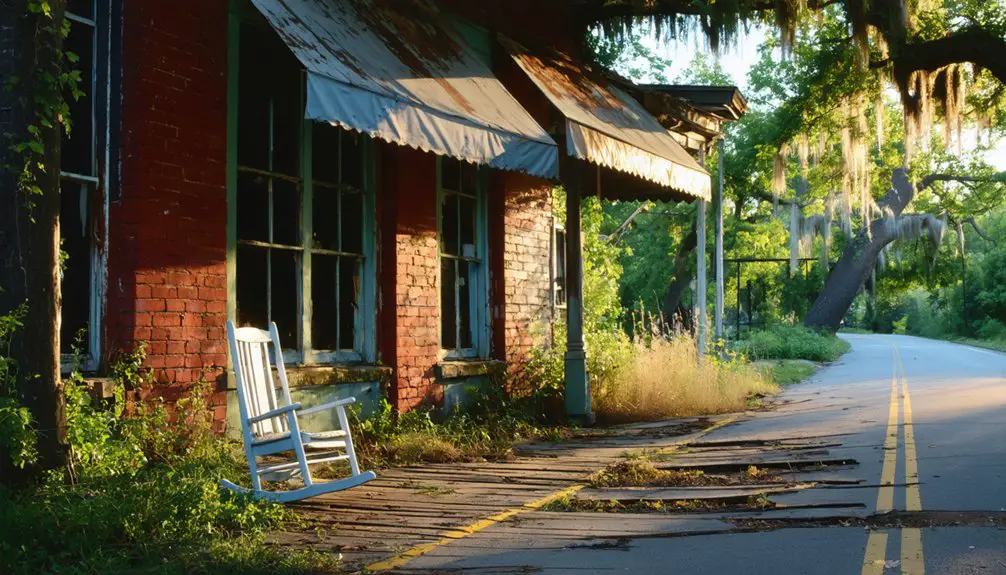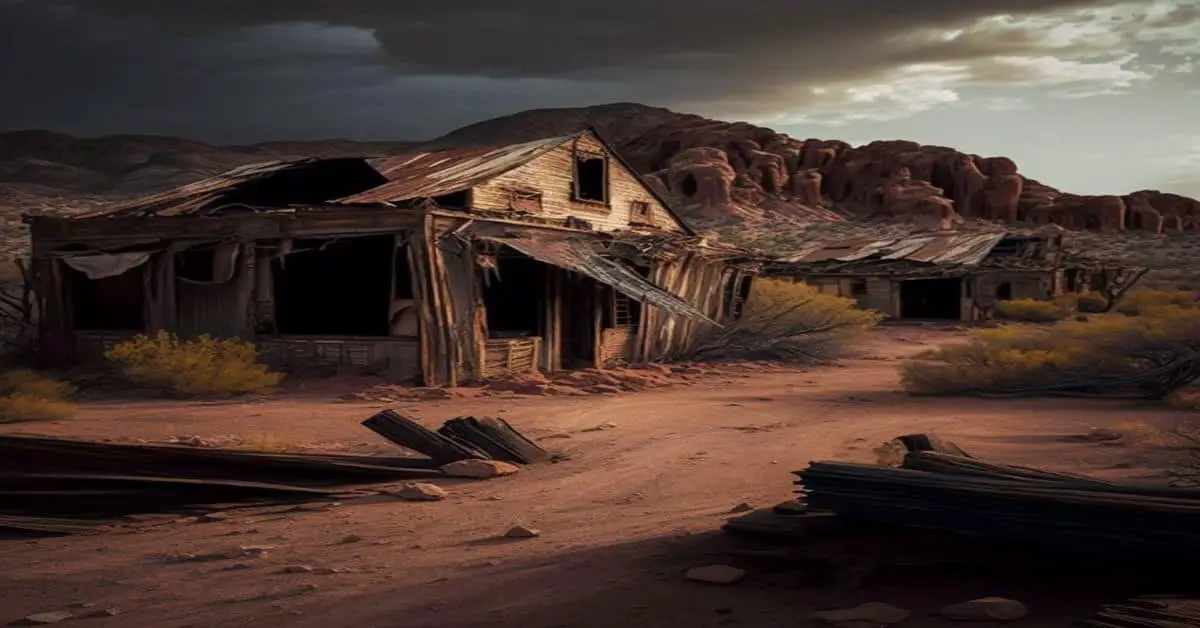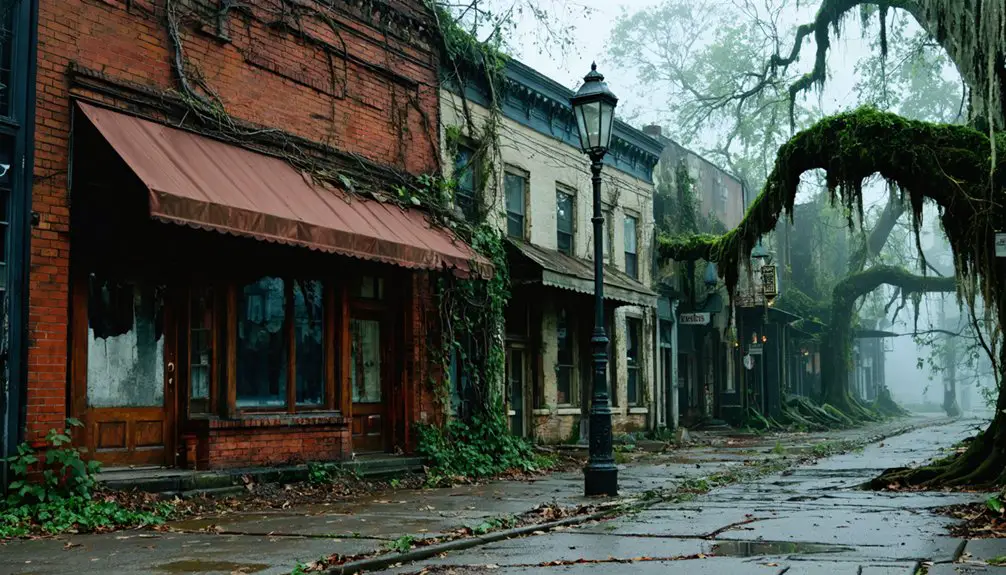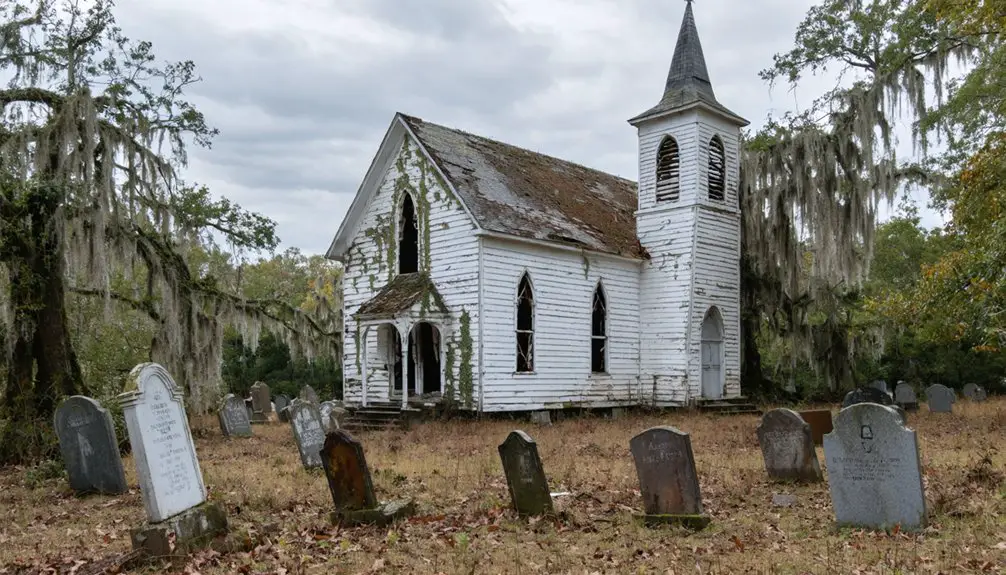You’ll find Ferguson’s remnants beneath Lake Marion’s waters in South Carolina, where this once-bustling lumber town thrived from 1881 until the 1940s. Founded by Francis Beidler and B.F. Ferguson, it served as headquarters for the Santee River Cypress Lumber Company, employing 2,500 workers who lived in a technologically advanced company town. Today, stone foundations and a lumber kiln rest silently underwater, holding secrets of the Southeast’s most innovative logging operation.
Key Takeaways
- Ferguson was a thriving lumber town founded in 1881 that now lies underwater in Lake Marion, South Carolina.
- The town supported up to 2,500 residents through the Santee River Cypress Lumber Company’s operations.
- Stone foundations and remnants of a lumber kiln can still be seen beneath Lake Marion’s waters.
- The town featured advanced amenities like paved roads, indoor plumbing, and gas lighting before its submergence.
- Ferguson disappeared in the 1940s when Lake Marion’s creation flooded the area, transforming it into a ghost town underwater.
The Rise of a Lumber Empire
In the wake of the Civil War, Chicago investors Francis Beidler and B.F. Ferguson seized an opportunity that would transform South Carolina’s timber industry. They founded the Santee River Cypress Lumber Company in 1881, acquiring 165,000 acres of virgin cypress forest at bargain prices throughout the Congaree, Wateree, and Santee River basins.
Their vision sparked remarkable economic growth as they built a thriving enterprise centered in Ferguson. Workers received their pay in company store scrip, limiting their purchasing power to Ferguson’s company-owned establishments. The operation thrived during an era when large sawmills were expanding rapidly across South Carolina after the Civil War.
The pioneering spirit of Beidler and Ferguson transformed a virgin wilderness into an economic powerhouse through their ambitious lumber enterprise.
You’ll find they constructed an impressive industrial complex featuring sawmills, kilns, and lumber drying facilities. The company town flourished, supporting up to 2,500 employees with modern amenities like paved roads, a school, hospital, and hotel.
Their strategic control of the region’s extensive timber resources positioned them as one of the South’s largest lumber operations, capitalizing on the nation’s growing demand for durable cypress wood.
Life in a Company-Controlled Town
If you lived in Ferguson during its lumber heyday, you’d have found your economic freedom severely limited by the company’s scrip system, which forced you to purchase all goods from company-owned stores.
While the town offered modern amenities like indoor plumbing and gas lighting that were rare in rural South Carolina, these comforts came with strict company oversight of daily life.
Your social status within Ferguson would have been clearly defined by your housing assignment, with management residences distinctly separated from worker accommodations.
Most families supplemented their wages by raising livestock and poultry in their fenced yards to help make ends meet.
At its peak, the state-of-the-art operation connected rural South Carolina’s lumber resources directly to the lucrative Chicago market.
Daily Life Under Control
Life in Ferguson revolved entirely around the lumber company’s iron grip, which extended far beyond the workplace into nearly every aspect of residents’ daily routines.
You’d find your worker autonomy severely limited – living in company-owned housing, sending your children to the company school, and seeking treatment at the company hospital. Much like Major Ferguson’s militia, the company maintained strict control over its personnel.
Even your community engagement was restricted by the town’s isolation from neighboring villages like Eutawville and Cross.
While you’d enjoy modern amenities like indoor plumbing and gas-lit streets – luxuries for rural South Carolina at the time – these comforts came with strings attached.
The company’s control over housing, healthcare, education, and essential goods created a web of dependency that was hard to escape, even though wages and conditions were better than in most logging towns.
The town’s existence came to an abrupt end when it was submerged by Lake Marion during the Santee-Cooper project.
Company Scrip Limits Freedom
The economic stranglehold of Ferguson’s lumber company extended beyond housing and services into the very money workers earned through an oppressive scrip system. You couldn’t spend your wages freely – instead, you’d receive company-issued tokens known as “Loonies” that were only good at the company store, where inflated prices ate away at your earnings. Due to cash scarcity in lumber camps, this practice was especially prevalent in the region.
Your scrip dependency grew deeper with each passing month as the company charged you for everything from work tools to transportation. The practice mirrored the exploitation seen in mining company stores where workers faced similar debt bondage.
If you fell behind on payments, you’d find yourself trapped in economic bondage, unable to leave Ferguson for better opportunities elsewhere. This system of control, common across Southern mill towns until the 1940s, kept you tethered to the company store, turning your hard work into a cycle of perpetual debt.
Housing and Social Structure
Built by Santee River Cypress Lumber Company in the late 1800s, Ferguson stood apart from typical logging settlements with its remarkable 350-house development featuring paved roads, indoor plumbing, and gas-lit streets.
While the worker accommodations surpassed standards of the era, you’d find yourself living in a strictly controlled environment. The company strategically designed separate housing for workers and management, reinforcing social hierarchies. Workers were paid in company store tokens rather than traditional currency. Like other towns requiring term disambiguation, multiple settlements named Ferguson existed across South Carolina during this period.
Your community engagement would’ve centered around company-sanctioned activities, with a modern school, hospital, and hotel all owned by your employer. With 2,500 residents at its peak, you’d live among a diverse workforce drawn from various regions, yet your social circle would remain confined within town limits due to geographic isolation and company oversight.
The town’s modern amenities came at the price of your independence.
Innovation and Infrastructure
During its brief but remarkable existence, Ferguson emerged as one of South Carolina’s most technologically advanced company towns, featuring innovations that set it apart from typical logging settlements of the era.
Ferguson stood as a marvel of innovation, redefining company towns with technological advances unseen in other South Carolina logging settlements.
You’d have found unprecedented urban resilience in its paved roads, indoor plumbing, and gas street lighting – amenities that demonstrated exceptional community sustainability for the early 1900s.
The town’s infrastructure supported 350 workers and their families with modern facilities including a state-of-the-art school, hospital, and hotel.
Rail lines connected Ferguson to Eutawville and Cross, enabling efficient lumber transport while maintaining the town’s deliberate isolation.
You wouldn’t have seen such thorough planning in ordinary logging camps, as Ferguson’s self-contained design created a controlled ecosystem where every aspect of life centered around the company’s operations.
The Cypress Logging Operations
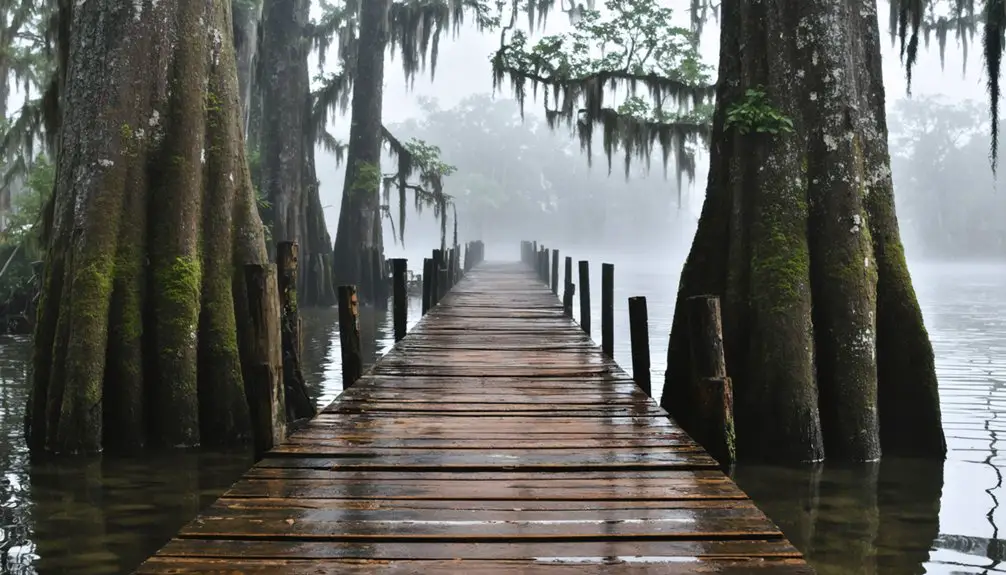
You’d find Ferguson’s logging crews deep in South Carolina’s swamps, harvesting towering virgin bald cypress trees that were then floated downriver to massive holding ponds near the mill.
The company’s strategic railroad networks connected Ferguson to Eutawville and Cross, enabling efficient distribution of processed lumber throughout the region.
At the mill site, workers transformed raw cypress logs into finished wood products through a vertically integrated operation that included both sawmill processing and kiln drying.
Massive Cypress Tree Harvests
In the late 1800s, the Santee River Cypress Lumber Company (SRCLC) launched one of the South’s largest cypress logging ventures, acquiring over 150,000 acres of pristine swampland along South Carolina’s major rivers.
You’d find their massive timber operation stretching across seventy-five miles of riverine floodplain, where they’d harvest ancient bald cypress trees from the swampy terrain.
The timber industry’s push southward came as northern forests were depleted, and you’d see why SRCLC seized the opportunity – cheap land prices and abundant virgin timber.
While they planned for continuous harvest cycles through natural regrowth, the landscape changed forever.
Today, you’ll still spot massive cypress stumps along creek beds in the Congaree area, silent witnesses to this era before cypress conservation became a priority.
Railroad Transport Systems
The Santee River Cypress Lumber Company‘s massive timber operation needed an equally impressive transport system to move its valuable cypress harvest.
They built an important rail spur connecting Ferguson to Cross, SC, enabling rapid railroad expansion throughout the cypress-rich swamplands. You’d have seen specialized steam locomotives rumbling down temporary tracks laid deep into the wetlands, dramatically improving transport efficiency compared to traditional river methods.
The company’s self-contained rail system served about 350 workers and supported Ferguson’s growth to 2,500 residents.
Their network included connections to broader markets through Cross’s interchange point, facilitating lumber shipments to Charleston and beyond. This railway infrastructure proved vital for moving giant cypress logs that would’ve been nearly impossible to transport by water alone, cementing Ferguson’s position as a major logging hub.
Lumber Processing Methods
Massive cypress logs from virgin swamplands along the Congaree, Wateree, and Santee Rivers arrived daily at Ferguson’s state-of-the-art mill complex, built strategically near Eutaw Springs around 1888.
You’d find the logs first stored in holding ponds to prevent splitting, then debarked before skilled sawyers transformed them into rough-cut lumber.
The mill’s innovative kiln drying techniques guaranteed proper moisture reduction, enhancing the wood’s natural water-resistant properties.
Workers then sorted the finished lumber through a precise lumber grade classification system, categorizing pieces by thickness and quality for various construction needs.
The mill’s emphasis on sustainable harvesting practices, championed by Francis Beidler, stood apart from other operations of the era, as he understood the swampland’s capacity for cypress regeneration.
Daily Life and Social Structure
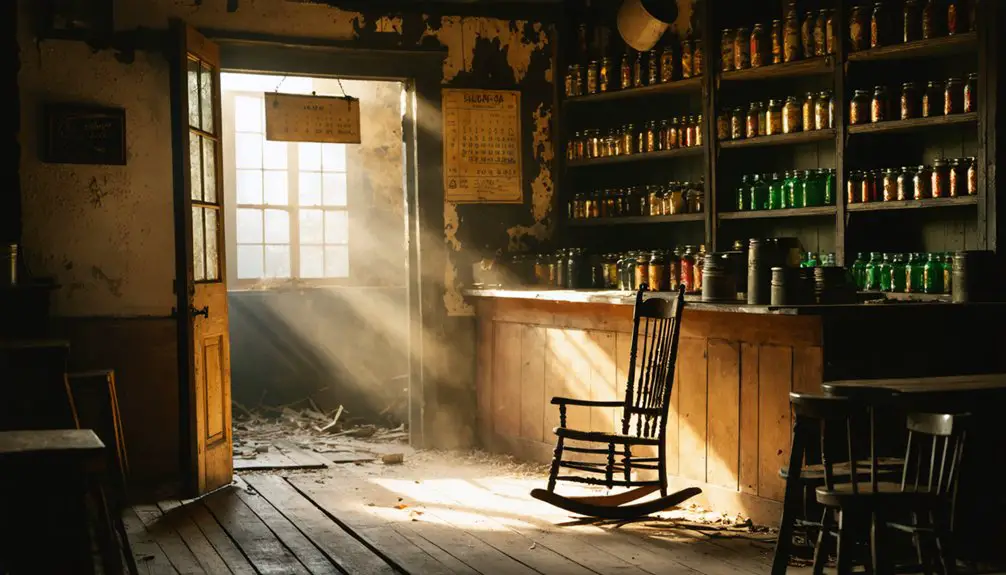
While many lumber mill towns of the early 1900s operated as temporary work camps, Ferguson established itself as a structured community where roughly 350 workers and their families experienced a blend of modern amenities and company control.
You’d find strong community connections in Ferguson’s self-contained world, with daily routines centered around the cypress mill’s operations.
Family dynamics revolved around company-provided facilities – a school for children, a hospital for health needs, and a hotel for visitors.
Though you’d enjoy modern conveniences like indoor plumbing and gas-lit streets, your economic freedom was limited by the company script system, forcing you to shop at company stores.
The town’s isolation from neighboring villages like Eutawville and Cross meant your social life stayed largely within Ferguson’s boundaries, creating a tight-knit but controlled society.
Health Challenges in the Swamplands
Living in Ferguson’s swampland environment meant confronting serious health threats on a daily basis, particularly from mosquito-borne diseases like malaria that thrived in the stagnant waters surrounding the town.
You’d have found yourself battling not just vector-borne diseases, but also waterborne pathogens from failing septic systems and contaminated runoff. The town’s hospital struggled to keep up with the constant flow of sick residents.
The damp conditions fostered mold growth and respiratory problems, while decaying vegetation released harmful gases.
If you ventured onto Lake Marion after the flooding, you’d have faced hidden dangers from submerged cypress trees and mill remnants.
Poor water quality, caused by sedimentation and bacterial contamination, made even drinking water a potential health risk for Ferguson’s resilient inhabitants.
Environmental Impact and Legacy
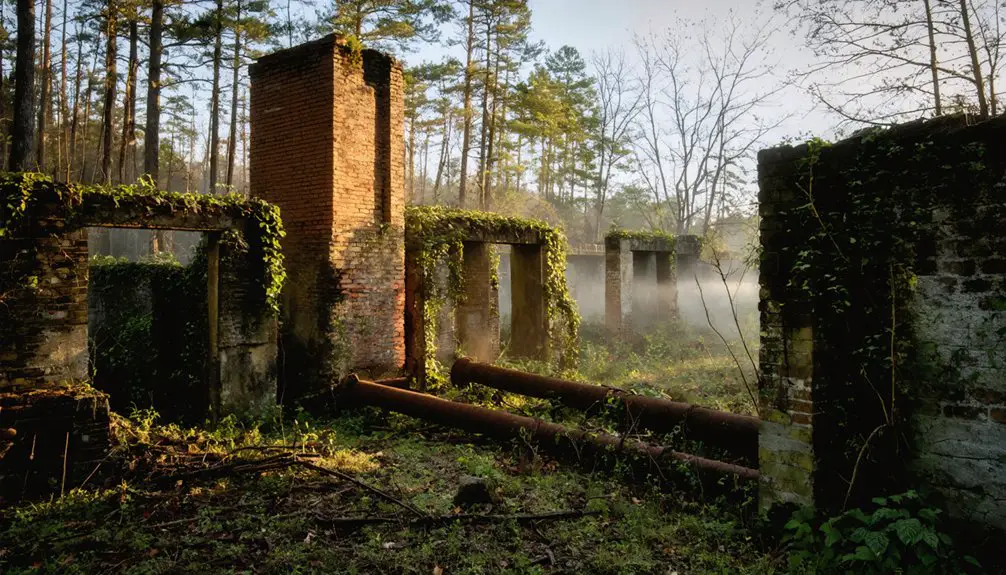
As Lake Marion’s waters engulfed Ferguson in the 1940s, the flooding forever altered the Santee River floodplain‘s delicate ecosystem.
You’ll find that the creation of the reservoir disrupted the ecological balance, submerging vast swaths of virgin cypress forests and transforming essential wetland habitats. The Santee River Cypress Lumber Company’s aggressive logging had already scarred the landscape, depleting old-growth forests without sustainable practices.
Today, you can spot remnants of Ferguson’s historical significance beneath the lake’s surface – foundations, a lumber kiln on Ferguson Island, and submerged cypress logs that divers occasionally recover.
The dam’s construction created South Carolina’s largest reservoir, converting terrestrial forests into an aquatic environment. While providing hydroelectric power, this transformation permanently changed the region’s hydrology, leaving a complex environmental legacy that continues to shape the lake’s ecosystem.
The Flooding of Ferguson
When the waters of Lake Marion began rising in the 1940s, Ferguson’s fate was already sealed by years of abandonment. The New Deal-era Santee Cooper project transformed this former lumber town into an underwater ghost town, with little effort made to salvage its remaining structures or timber.
The flooding aftermath left a haunting legacy beneath Lake Marion’s surface. You’ll find submerged artifacts from the town’s heyday, including building foundations and countless cypress logs that were hastily anchored before the waters rose.
The old lumber kiln on Ferguson Island stands as a lone sentinel above the waterline, marking where a thriving community once processed timber. During droughts, you can glimpse traces of the town’s footprint when lake levels drop, revealing the remnants of South Carolina’s forgotten lumber empire.
Preserving a Submerged History
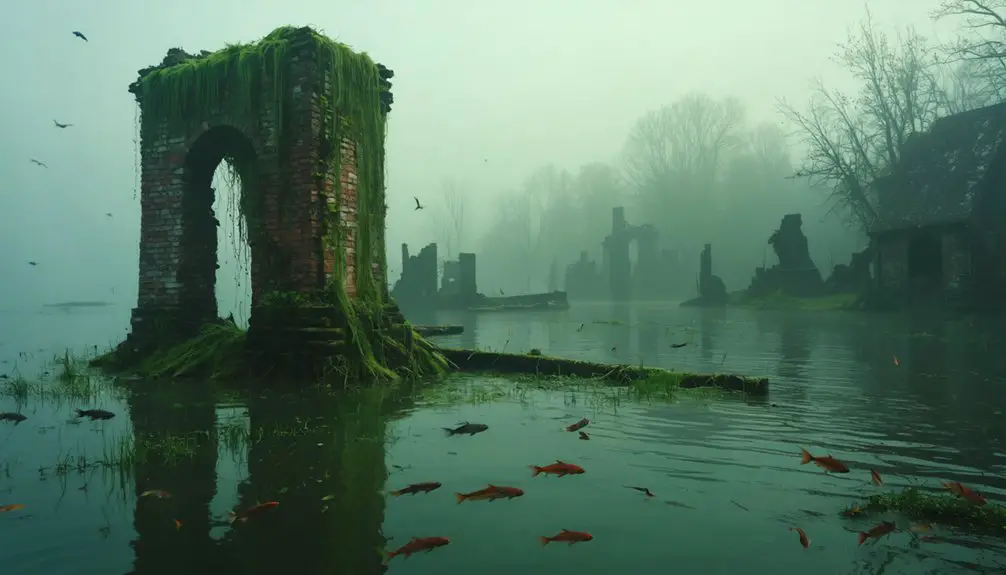
Despite Ferguson’s watery fate, dedicated efforts maintain its submerged legacy through multiple channels.
You’ll find artifact protection measures enforced by the South Carolina Public Service Authority, including signs prohibiting unauthorized access to prevent looting of historical items during drought periods.
The town’s memory lives on through oral histories collected by Caldwell Loftis, particularly Richard Mims’ accounts, now housed at the South Caroliniana Library.
During low water levels, you can spot physical remnants like foundations, stonework, and the old lumber kiln’s remains.
When waters recede, Ferguson’s ghostly ruins emerge – stone foundations and remnants of the lumber kiln rising from Lake Marion’s depths.
Researchers from the University of South Carolina continue documenting the town’s history through photographs, maps, and family accounts.
These preservation efforts guarantee that even though Ferguson lies beneath Lake Marion’s waters, its story won’t be lost to time.
Frequently Asked Questions
What Happened to the Residents After Ferguson Was Flooded?
You’ll find that most residents had already moved to neighboring towns before the flood recovery began, as community displacement happened gradually after the 1915 mill closure, not during Lake Marion’s creation.
Are There Any Surviving Former Residents of Ferguson Still Alive Today?
Out of Ferguson’s 350 former residents, just one person with childhood connections remains – Mr. Mims, who explored the abandoned town before flooding. Other surviving stories come from resident memories preserved through oral histories.
What Dangerous Wildlife Was Commonly Encountered in Ferguson During Its Operation?
You’d have faced wildlife encounters with alligators, venomous snakes like cottonmouths and copperheads, black bears, and bobcats. Mosquitoes carrying malaria were among the most dangerous local dangers.
How Deep Underwater Are Ferguson’s Remaining Structures in Lake Marion?
Like treasures in Neptune’s vault, you’ll find Ferguson’s underwater structures at varying depths, typically 10-20 feet below Lake Marion’s surface, with some foundations near Ferguson Island visible during low water levels.
Did Any Buildings Get Relocated Before the Town Was Submerged?
No, you won’t find any records of relocated buildings. Despite the town’s historical significance, there wasn’t any town preservation effort – all structures were simply abandoned and left to be submerged under Lake Marion.
References
- https://www.randomconnections.com/the-ghost-towns-of-lake-marion-part-2-ferguson/
- https://sc.edu/uofsc/posts/2020/05/memories_of_a_drowned_town.php
- https://www.randomconnections.com/the-ghost-towns-of-lake-marion/
- https://crimeandcask.com/city-of-ferguson-submerged-lake-marion/
- https://en.wikipedia.org/wiki/Ferguson
- https://www.scfc.gov/about-us/history/a-short-history-of-forest-industry-in-south-carolina/
- https://thebhc.org/abstract-viewer/popup/263
- https://www.thecolumbiastar.com/articles/pineville-a-historic-refuge-ferguson-the-origins/
- https://www.thecolumbiastar.com/articles/pineville-a-historic-refuge-ferguson-the-final-years/
- https://www.randomconnections.com/the-ghost-towns-of-lake-marion-part-3-the-water-rises/
